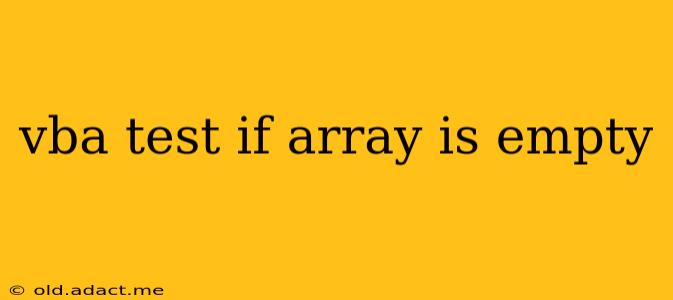Determining whether an array is empty in VBA (Visual Basic for Applications) isn't as straightforward as it might seem. The method you use depends on how the array was declared and initialized. This guide will cover several scenarios and provide robust solutions for each.
Understanding VBA Array Declaration and Initialization
VBA arrays can be declared and initialized in several ways, each impacting how you check for emptiness:
-
Explicitly Sized:
Dim myArray(1 To 10) As IntegerThis creates an array with 10 elements, initially filled with default values (0 for numbers, "" for strings, etc.). It's not empty, even if you haven't assigned any specific values. -
Dynamically Sized:
Dim myArray() As StringThis creates an array that can resize dynamically. Initially, it's considered empty. You'll add elements usingReDimor other methods. -
Using
Array()Function:Dim myArray As Variant: myArray = Array("apple", "banana")This creates an array with pre-populated values.
Methods to Check for Empty Arrays in VBA
Here are the most reliable ways to check for empty arrays in VBA, addressing different declaration methods:
1. UBound Function for Explicitly Sized Arrays
For arrays declared with a fixed size (e.g., Dim myArray(1 To 10) As Integer), checking the upper bound (UBound) can indicate emptiness only if you've explicitly initialized the array to contain no values. Remember, a declared but uninitialized array of this type is not truly empty; it contains default values.
Sub CheckExplicitlySizedArray()
Dim myArray(1 To 10) As Integer
' Check if array is truly empty (all elements default values). This is not a reliable test for general empty array detection.
If UBound(myArray) < LBound(myArray) Then 'This is true if no elements have been added
MsgBox "The explicitly sized array is empty (all default values)."
Else
MsgBox "The explicitly sized array is not empty."
End If
End Sub
Important: This approach is unreliable if you’ve assigned default values. Consider using a different method if you have explicitly sized array and assign values later, or need a more robust check.
2. UBound and LBound for Dynamically Sized Arrays
For dynamically sized arrays (declared as Dim myArray() As Variant), checking both UBound and LBound is the most common and reliable method. An empty dynamically sized array will have a lower bound (LBound) greater than its upper bound (UBound).
Sub CheckDynamicArray()
Dim myArray() As String
If UBound(myArray) < LBound(myArray) Then
MsgBox "The dynamic array is empty."
Else
MsgBox "The dynamic array is not empty."
End If
'Example with elements
ReDim myArray(1 To 2)
myArray(1) = "apple"
myArray(2) = "banana"
If UBound(myArray) < LBound(myArray) Then
MsgBox "The dynamic array is empty."
Else
MsgBox "The dynamic array is not empty."
End If
End Sub
3. Checking the Number of Elements (for Variants)
If your array is a Variant and you are unsure if it is empty you can try this (it works with empty arrays created using Dim arr() as Variant).
Sub CheckVariantArray()
Dim myArray() As Variant
Dim i As Long
'Check if array is empty
If IsEmpty(myArray) Then
MsgBox "The variant array is empty."
Else
MsgBox "The variant array is not empty."
End If
'Example with elements
ReDim myArray(1 To 2)
myArray(1) = 1
myArray(2) = 2
'Check if array is empty again
If IsEmpty(myArray) Then
MsgBox "The variant array is empty."
Else
MsgBox "The variant array is not empty."
End If
End Sub
This method checks whether the variable is uninitialized, which is the same as an empty array in this scenario.
4. Error Handling with UBound (Robust Approach)
This approach handles potential errors that might occur if you try to check UBound on an uninitialized array:
Sub CheckArrayRobustly()
Dim myArray() As Integer
On Error Resume Next ' Suppress error if array is uninitialized
Dim upperBound As Long
upperBound = UBound(myArray)
On Error GoTo 0 ' Re-enable error handling
If Err.Number <> 0 Then
MsgBox "The array is uninitialized (empty)."
ElseIf upperBound < LBound(myArray) Then
MsgBox "The array is empty."
Else
MsgBox "The array is not empty."
End If
End Sub
This is the most robust and recommended method as it accounts for both uninitialized and empty scenarios without crashing your code.
Remember to choose the method that best suits your array's declaration and usage. For dynamically sized arrays, comparing UBound and LBound is the most reliable way to determine if the array is empty. For variant arrays, using IsEmpty is more appropriate. Using error handling adds robustness to your code.
